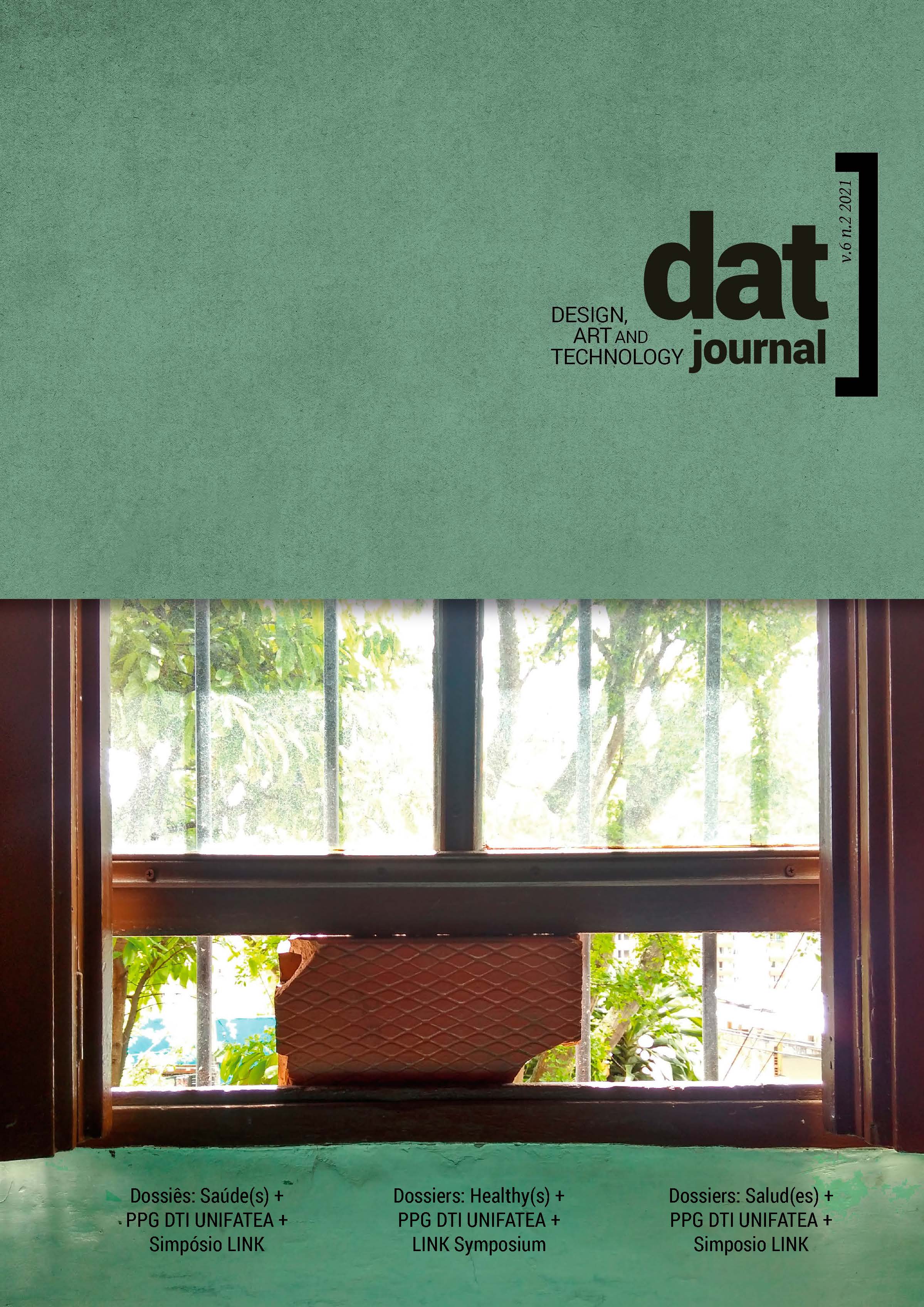Habilidades de diseño, mentalidades y métodos de investigación y diseño para prácticas revolucionarias
DOI:
https://doi.org/10.29147/dat.v6i2.408Palabras clave:
Métodos de investigación, Usos queer, Resultados de investigación no tradicionales, Métodos de diseñoResumen
Este artículo se basa en las identidades complementarias de un "diseñador investigador" como una persona que informa su práctica de diseño con la investigación y un "investigador de diseño" como una persona que informa su práctica de investigación con el diseño. Aquí, extiendo y examino esta dualidad reductiva prestando mucha atención a las habilidades, mentalidades, métodos y prácticas en el diseño y la investigación. Sostengo que cuando las habilidades, herramientas, técnicas y métodos normalmente utilizados en la actividad de diseño se utilizan en la actividad de investigación, es necesario articular distinciones claras sobre los propósitos y contextos de su uso. Las personas que están en condiciones de ejecutar roles tan diferentes como el diseño y la investigación pueden considerarse "ambidiestros" o "revolucionarios", ya que tienen el potencial de cultivar sinergias disruptivas entre estos mundos. El documento aborda la rica diversidad, las oportunidades y riesgos, y las tensiones éticas que surgen de "cambiar de sombrero" entre las prácticas establecidas de diseño e investigación, y los usos "queer" de los métodos en tales intersticios. Me baso en trabajos anteriores sobre la adaptación creativa de métodos de diseño para la investigación interdisciplinaria (Sosa & Grocott, 2020). El artículo concluye con preguntas generativas para quienes se embarcan en las prácticas revolucionarias emergentes entre el diseño y la investigación.
Descargas
Citas
Agid, S., & Akama, Y. (2020). Reflexive account-giving through ‘practice notations’: plural dimensions and dynamics of infrastructuring. Proceedings of the 16th Participatory Design Conference 2020-Participation (s) Otherwise-Volume 2, Ahmed, S. (2019). What's the Use?: On the Uses of Use. Duke University Press.
Beck, J., & Stolterman, E. (2016). Examining the types of knowledge claims made in design research. She Ji: The Journal of Design, Economics, and Innovation, 2(3), 199-214.
de Sousa Santos, B. (2014). Epistemologies of the South: justice against epistemicide. Paradigm Publishers.
Esparza, A. (2020). Entrepreneurship With Additive Manufacturing: Implications of Complexity Freedom in Product and Firm Ideation AUT University]. Auckland. http://hdl.handle.net/10292/13125
Finke, R. A. (1996, 1996/09/01/). Imagery, Creativity, and Emergent Structure. Consciousness and Cognition, 5(3), 381-393. https://doi.org/10.1006/ccog.1996.0024
Frayling, C. (1994). Research in art and design (Royal College of Art Research Papers, Issue.
Freire, P. (2000). Pedagogy of the oppressed. Continuum.
Gold, R. (2007). The plenitude: Creativity, innovation, and making stuff. Mit Press.
Goodman, N. (1976). Languages of Art, an Approach to a Theory of Symbols. Hackett.
Gray, C., & Malins, J. (2016). Visualizing research: A guide to the research process in art and design. Routledge. Hanington, B. (2003). Methods in the making: A perspective on the state of human research in design. Design Issues, 19(4), 9-18.
Haseman, B. (2007). Rupture and recognition: Identifying the performative research paradigm. In E. Barrett & B. Bolt (Eds.), Practice as research: Approaches to creative arts enquiry (pp. 147-157). Tauris, I.B.
Kara, H. (2015). Creative Research Methods in the Social Sciences: A Practical Guide. Policy Press.
Kitcher, P. (2000). A priori knowledge revisited. In P. Boghossian & C. Peacocke (Eds.), New Essays on the A Priori (pp. 65-91). Clarendon Press.
Kocienda, K. (2018). Creative Selection: Inside Apple's design process. Macmillan.
Kuhn, T. S. (1996). The structure of scientific revolutions. Chicago, Ill. : University of Chicago Press, 1996.
Kumar, V. (2013). 101 Design Methods: A Structured Approach for Driving Innovation in your Organization. Wiley.
Laurel, B. (2003). Design research: Methods and perspectives. MIT press.
Law, J. (2004). After Method: Mess in Social Science Research. Routledge.
Montiel, M., Sosa Medina, R., & Hocking, D. (2020). Activity Scenario Modelling: an emerging method for examining human-artefact interaction. Synergy - DRS International Conference 2020, Online.
Moradi, P., Hunting, A., & Sosa Medina, R. (2019, 2019/11/21/). A UX Pedagogy on Multimodal Aspects of Emotions. Fifth International Conference for Design Education Researchers, Ankara.
Pei, E., Campbell, I., & Evans, M. (2011). A taxonomic classification of visual design representations used by industrial designers and engineering designers. The Design Journal, 14(1), 64-91.
Senge, P. M., Smith, B., Kruschwitz, N., Laur, J., & Schley, S. (2008). The necessary revolution: How individuals and organizations are working together to create a sustainable world. Currency.
Slocum, N. (2003). Participatory Methods Toolkit: A Practitioner’s Manual. United Nations University.
Sosa, R., & Grocott, L. (2020). The creative translation of design methods into social research contexts. In H. Kara & S. Khoo (Eds.), Researching in the Age of COVID-19 Vol 3: Volume III: Creativity and Ethics (Vol. 3, pp. 9-19). Policy Press.
St. Pierre, E. A. (2021). Post qualitative inquiry, the refusal of method, and the risk of the new. Qualitative Inquiry, 27(1), 3-9.
Stappers, P. J. (2007). Doing design as a part of doing research. In Design research now (pp. 81-91). Springer.
Telenko, C., Sosa, R., & Wood, K. L. (2016). Changing conversations and perceptions: The research and practice of design science. In C. A. & L. U. (Eds.), Impact of Design Research on Industrial Practice (pp. 281-309). Springer. https://doi.org/https://doi.org/10.1007/978-3-319-19449-3_19
Vaughan, L. (2017). Practice-based Design Research. Bloomsbury Publishing.
Verswijvelen, M., Sosa, R., & Martini, N. (2020, August 2020). Designing game-inspired narratives for learning. Synergy - DRS International Conference 2020, Online.
Walker, S. (2013). Imagination’s promise: Practice-based design research for sustainability. In The handbook of design for sustainability (pp. 446-465). Bloomsbury Academic.
Yee, J. (2017). The researcherly designer/the designerly researcher. In L. Vaughan (Ed.), Practice-based Design Research (pp. 155). Bloomsbury Academic.
Zimmerman, J., & Forlizzi, J. (2008). The role of design artifacts in design theory construction. Artifact: Journal of Design Practice, 2(1), 41-45.


























